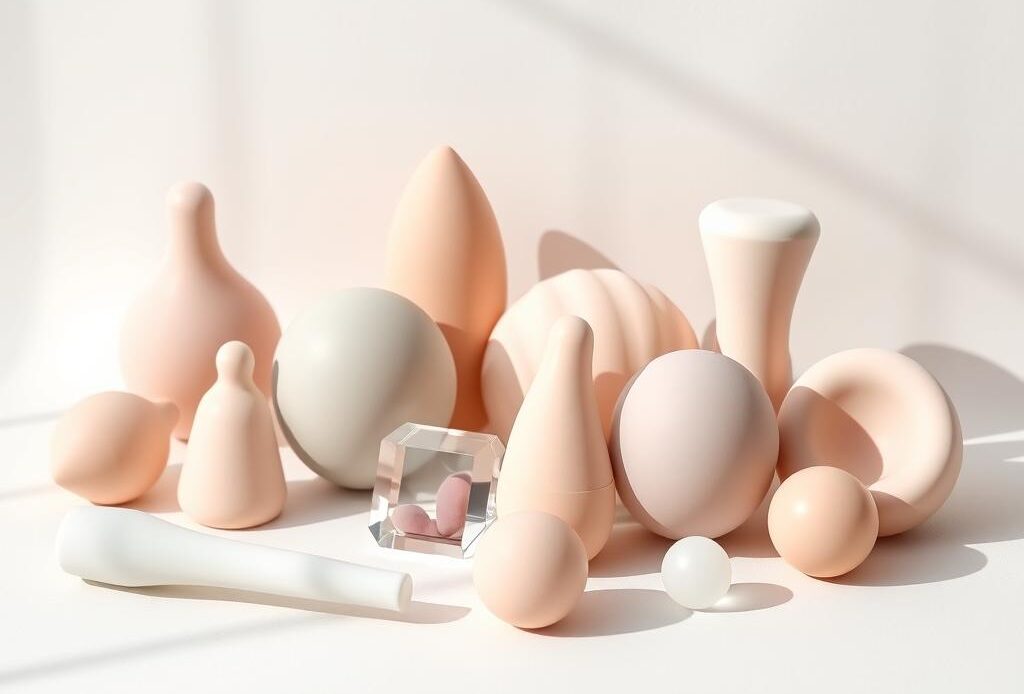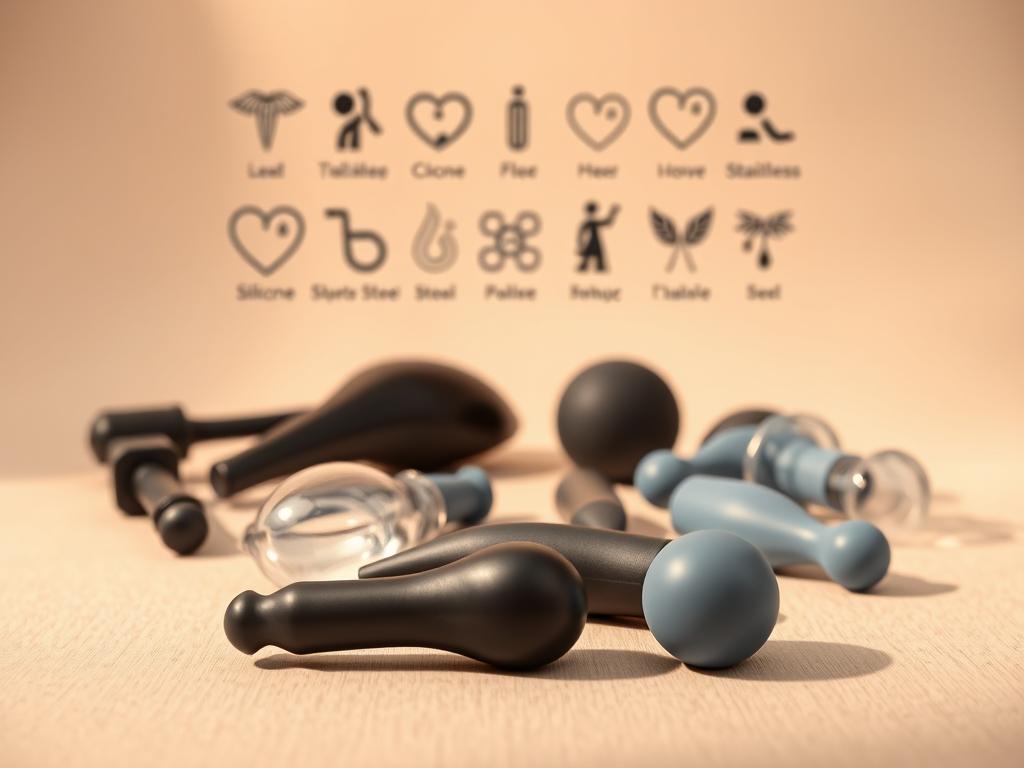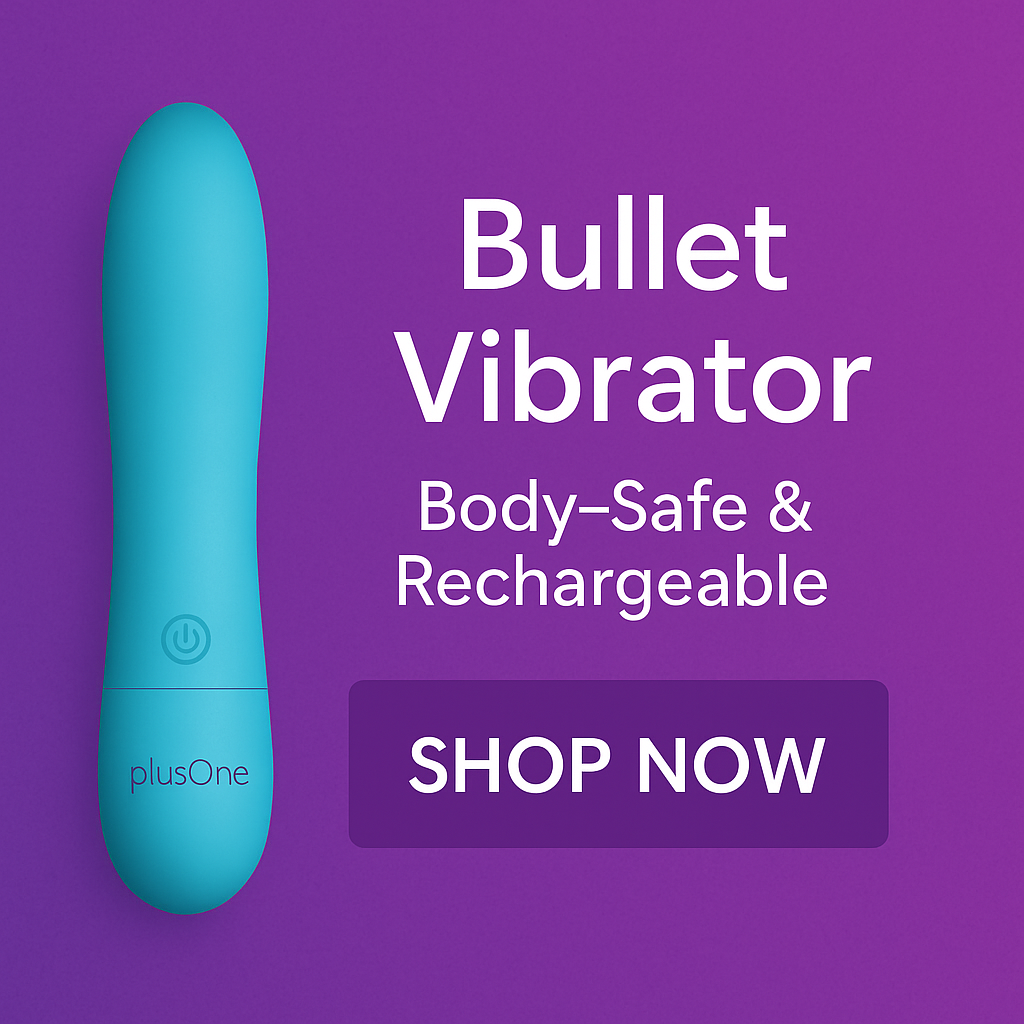
For thousands of years, people have explored pleasure through creative tools – from ancient stone carvings to modern innovations. Today, intimate wellness products are celebrated as tools for self-discovery and empowerment. But not all options are created equal, and knowing what you’re buying matters more than ever.
Unlike regulated industries, manufacturers of sensual items aren’t required to disclose their ingredients. This gap leaves many shoppers unaware of potential risks hidden in low-quality designs. We believe everyone deserves transparency and trust when selecting products that touch their skin.
Our team tests every item against strict health standards, rejecting anything with questionable components. In this guide, you’ll learn how to spot durable, non-toxic designs and avoid common pitfalls. We’ll also share care tips to extend your collection’s lifespan and enhance your experience.
Key Takeaways
- Intimate wellness tools have evolved from taboo to mainstream self-care essentials
- Manufacturers aren’t legally required to disclose product ingredients
- Non-porous surfaces prevent bacterial growth and simplify cleaning
- Premium designs often cost more upfront but last significantly longer
- Proper storage extends product lifespan and maintains performance
- Certifications like medical-grade silicone indicate higher safety standards
Overview of the Sex Toy Industry and Our Commitment
Cultural shifts transformed once-hidden items into celebrated tools for self-care and empowerment. Today’s market thrives on openness, blending ancient wisdom with cutting-edge technology. We’re proud to contribute to this movement by prioritizing health-focused designs.
Historical Context and Cultural Shift
Archaeologists found 28,000-year-old stone objects designed for pleasure – proof that self-discovery isn’t a modern concept. Fast-forward to the 20th century, and these items were sold under coded names like “massagers.” The real change came when sex-positive brands started normalizing conversations about intimacy.
During the pandemic, sales surged by 52% as people explored new ways to connect with themselves. This boom pushed the industry into mainstream retail spaces, with sleek designs appearing in wellness blogs and lifestyle magazines.
Moving from Stigma to Sexual Empowerment
We’ve witnessed a remarkable shift. What was once whispered about is now discussed openly in podcasts and social media. Our team partners with engineers and health experts to create products that respect both your body and your curiosity.
| Era | Materials | Accessibility | Cultural Perception |
|---|---|---|---|
| Ancient Times | Stone, Wood | Limited | Sacred/Ritualistic |
| 1950s-1990s | Rubber, PVC | Discreet Mail-Order | Taboo |
| 2020s | Medical Silicone | Online & Retail Stores | Wellness Essential |
Three pillars guide our work: ethical sourcing, transparent labeling, and community education. Every product we offer undergoes third-party testing – because informed shopping should be simple, not a scavenger hunt.
Understanding Body Safe Sex Toy Materials
Imagine buying skincare without ingredient lists – that’s the reality for many pleasure products. The term “body-safe” carries weight here, but its meaning gets murky without standardized definitions. We’re cutting through the confusion to help you make empowered choices.

Decoding Unregulated Labels
No government agency oversees these products’ composition, letting some manufacturers use cheap components that might irritate skin or leach harmful substances. Non-porous options like medical-grade silicone create barriers against bacteria, while porous alternatives can trap moisture and microbes. Our testing process rejects anything containing phthalates or petroleum-based gels.
Health First, Always
Low-quality components might cause allergic reactions or disrupt natural pH balances. One customer shared how switching to certified designs resolved persistent discomfort they’d blamed on other factors. That’s why we partner with labs to verify every product’s composition before it reaches you.
Key differentiators in our approach? Full transparency about origins, third-party certifications, and educational resources. While others prioritize flashy packaging, we obsess over what’s inside. Your well-being isn’t negotiable – it’s the foundation of genuine enjoyment.
Common Materials Used in Sex Toys
Navigating product options can feel overwhelming without clear guidelines. The secret to confident choices lies in material science – understanding what’s built to last versus what might compromise your well-being.
Nonporous vs. Porous: What to Look For
Nonporous surfaces act like armor against microbes. Their smooth structure leaves no room for bacteria to hide, allowing full sterilization with soap or toy cleaner. Porous options? They’re sponge-like, trapping moisture and creating breeding grounds for unwelcome guests.
This difference matters most for internal-use items. Nonporous designs prevent lingering odors and maintain hygiene long-term. Our testing team rejects any porous product that can’t withstand boiling water or hospital-grade disinfectants.
Trusted Materials: Silicone, ABS, Glass, and Metal
Medical-grade silicone leads the pack. It’s hypoallergenic, heat-resistant, and adapts to body warmth. For those exploring their first purchase, our silicone vs. ABS comparison breaks down flexibility versus firmness preferences.
ABS plastic shines in sleek, rigid designs that clean with a quick wipe. Borosilicate glass offers temperature play possibilities, while stainless steel provides weighty luxury. Both metal and glass options survive dishwasher cycles, making maintenance effortless.
- Nonporous surfaces = easier cleaning + longer lifespan
- Medical certifications ensure silicone meets implant standards
- Glass and steel won’t degrade over years of use
Knowledge transforms shopping from guesswork to empowerment. When you recognize premium components, you invest in experiences that prioritize both joy and well-being.
Risks and Concerns with Toxic Sex Toy Materials
You wouldn’t buy a water bottle that leaks chemicals – why settle for less with intimate products? Hidden risks lurk in some designs, from hormone-disrupting additives to surfaces that trap bacteria. Let’s unpack what makes certain components harmful and how to spot them.
Phthalates, Chemicals, and Their Health Impact
Phthalates – plastic softeners banned in children’s toys – still appear in cheaper pleasure products. These chemicals can leach into skin, potentially disrupting reproductive health or triggering allergies. A landmark study found 52% of tested items contained concerning additives linked to long-term health issues.
Common symptoms include irritation, burning sensations, or recurring infections. Over time, exposure might affect internal systems, especially with frequent use. We reject any design containing these unstable compounds, prioritizing your well-being over cost-cutting shortcuts.
Identifying Unsafe and Porous Materials to Avoid
Watch for these red flags: rubbery smells, cloudy finishes, or labels saying “for novelty use.” PVC and TPE/TPR often contain phthalates and degrade quickly. Porous surfaces – think spongy textures – absorb fluids and breed bacteria even after cleaning.
Our checklist helps you shop smarter:
- Avoid jelly-like textures or overly flexible designs
- Steer clear of products listing “fragrance” without details
- Choose nonporous options for easier sterilization
Knowledge transforms your buying power. By understanding these risks, you’re equipped to select items that celebrate – never compromise – your health.
Caring for and Cleaning Your Body-Safe Toys
Maintaining your collection is like caring for fine jewelry – simple habits preserve beauty and function. Proper hygiene prevents bacterial buildup while protecting your investment in premium designs. Let’s explore methods that keep items pristine without complicated routines.
Effective Cleaning and Sanitizing Methods
Warm water and mild soap work wonders for most items. Non-porous surfaces wipe clean easily, while textured areas may need a soft toothbrush. Always check manufacturer guidelines – some electronics can’t handle submersion.
For deeper sanitizing, boil non-motorized pieces for 3 minutes or run dishwasher-safe options through a cycle. UV sterilizers offer chemical-free disinfection, ideal for sensitive users. Remember: moisture breeds bacteria – dry thoroughly with microfiber cloths before storage.
Vibrating designs require extra care. Use alcohol wipes on external surfaces, avoiding charging ports. Store cords neatly to prevent tangling or damage. Consistent cleaning not only protects your health but also ensures peak performance every time.
With these easy clean strategies, you’ll enjoy peace of mind alongside pleasure. A little maintenance goes a long way in creating experiences that feel as good tomorrow as they do today.
Expert Tips for Selecting Quality Products
Labels shouldn’t feel like hieroglyphics. With a few key insights, you can spot trustworthy designs that prioritize your well-being while delivering exceptional experiences.

Cutting Through Marketing Noise
Look for specific certifications rather than vague terms like “body-friendly.” Reputable brands list materials using scientific names (platimum-cured silicone, not just “soft plastic”). One industry insider notes: “If a company hides ingredients, question what else they’re hiding.”
Common myths trip up even savvy shoppers. While some suggest boiling used sex toys makes them safe, porous materials can’t be fully sterilized. For items made with unclear components, risks linger no matter how thoroughly you clean them.
Trusted manufacturers often use:
- Third-party lab test results
- Clear care instructions
- Warranties backing material claims
When shopping sex toys, prioritize retailers that explain why certain designs outperform others. Our guide on choosing your first item simplifies this process. Remember: premium products cost more because they invest in safety testing, not flashy packaging.
Compare product descriptions side-by-side. Phrases like “phthalate-free” or “non-porous” signal transparency, while “novelty use only” often masks low-quality components. By focusing on these details, you’ll build a collection that delights without compromise.
Navigating the Sex Toy Shopping Experience
Smart shopping starts with knowing what questions to ask. Trustworthy retailers welcome inquiries about product origins and testing processes. If a seller hesitates to share details, consider it a flashing warning sign.
Spotting Quality Through the Clutter
A strong chemical odor often signals low-grade components. One customer reported a rubbery smell from a discounted item that caused skin irritation. Always sniff-test products before use – premium designs should have minimal or no scent.
| Feature | Trustworthy | Questionable |
|---|---|---|
| Material List | Specific terms like “platinum silicone” | Vague phrases like “skin-safe polymer” |
| Price Point | Reflects material/testing costs | Unnaturally low for claimed quality |
| Return Policy | 30+ day satisfaction guarantee | “Final sale” only |
Three essential questions to ask retailers:
- “Can you provide third-party lab results?”
- “What’s your return policy for allergic reactions?”
- “Does this design work with oil-based lubricants?”
When uncertain about porous items, use condoms as a protective barrier. This simple step reduces infection risks while you research better alternatives. Remember: true bargains protect your health – cheap sex toys often cost more in long-term consequences.
Prioritize brands that detail cleaning methods and compatibility with sterilizing tools. Your confidence in a purchase should match the care put into its creation. With these strategies, you’ll transform overwhelming choices into empowered decisions.
Conclusion
Your well-being deserves more than guesswork when choosing intimate products. Selecting nonporous, non-toxic designs isn’t just about comfort – it’s a commitment to your long-term health. Nonporous surfaces prevent bacterial buildup, while porous alternatives risk compromising your sexual wellness.
We stand by every product with third-party testing and medical-grade standards. Our team rejects cheap plastics and unstable components, ensuring you receive items built for both pleasure and lasting safety. When shopping, prioritize brands that disclose materials and welcome questions about their production processes.
Knowledge transforms overwhelming choices into confident decisions. Ask about certifications, cleaning methods, and compatibility with lubricants. While premium options may cost more upfront, they protect your health while delivering superior experiences.
Remember: your journey toward empowerment begins with informed choices. Let this guide light your way forward – because feeling good should never come at the cost of feeling secure. We’re here to help you create moments that honor both your curiosity and your care.
FAQ
What makes a material “body-safe” for intimate products?
We prioritize nonporous, hypoallergenic options like medical-grade silicone, stainless steel, or borosilicate glass. These resist bacteria growth, don’t absorb moisture, and won’t leach harmful chemicals—unlike porous plastics or rubber.
Are there specific ingredients or materials I should avoid?
Yes! Steer clear of phthalates (often hidden as “fragrance”), PVC, jelly rubber, or TPE/TPR. These can irritate skin, disrupt hormones, or degrade over time, creating cracks where bacteria thrive.
How do I clean nonporous toys effectively?
Use mild, unscented soap and warm water. For silicone, boiling or using a 10% bleach solution works. Glass and metal can often go in the dishwasher—just check the manufacturer’s guidelines first!
Can porous toys ever be safe if cleaned thoroughly?
We don’t recommend them. Porous surfaces trap bacteria and oils even after washing, raising infection risks. If you own one, cover it with a condom and replace it frequently.
What red flags should I notice while shopping?
Watch for vague terms like “sil-a-gel” or “skin-safe rubber.” Trust brands like Lelo, We-Vibe, or nJoy that disclose materials openly. Avoid strong chemical smells or overly cheap prices—quality costs more.
Does a higher price always mean better safety?
Not always, but extremely low-cost items often cut corners. We suggest investing in reputable companies like Dame or Fun Factory, which use certified silicone and avoid toxic additives.
How can I verify a brand’s claims about safety?
Look for third-party certifications (like USP Class VI or FDA-approved materials) or reach out directly. Transparent brands, such as Satisfyer or BMS Factory, provide detailed material info and testing results.

